Abstract
The paper presents results of the investigation of the AlCrN and AlCrN + CrCN coatings, deposited by arc evaporation method on the austenitic steel substrate. Topography studies performed with the use of AFM showed that the roughness value was 24 nm for AlCrN and 14 nm for CrCN. Chemical analysis carried out with energy dispersive X-rays spectroscopy confirmed the chemical composition of the coatings. Transmission electron microscopy (TEM) investigations showed a column structure of AlCrN and CrCN layers with a width in the range of 10–200 nm. Tribological properties analyzed using a scratch test and ball-on-disc method showed a good adhesion of the coatings to the substrate (LC2 is 40 and 46 N for AlCrN and AlCrN + CrCN, respectively) and its high wear resistance; the use of an additional CrCN layers caused a decrease in the friction coefficient by 19%. Structure modification of the AlCrN + CrCN coating system and the related improvement in its mechanical and tribological properties allowed increasing the lifetime of the coated elements. The original approach was to produce a dual-layer coating, consisting of an internal, hard AlCrN layer and an external layer of CrCN, providing good tribological properties, as well as an appropriate forming of the transition zone between the layers.
1. Introduction
Chromium-based ceramic coatings, e.g., CrN, currently consist of a group of wear-resistant coatings. They can be successfully used as an alternative to TiN layers, especially in hot work processes. CrN shows better high-temperature resistance than TiN and also performs well in sliding wear and corrosive environments’ applications [1,2,3]. Various two-component and three-component nitride coatings can be used to increase the lifespan of tools and machine elements working in different, often extreme, or highly corrosive environments exposed to abrasive conditions and environments [4,5]. These coatings have gained several applications thanks to their properties (i.e., high hardness, corrosion, and wear resistance). In recent years, the area of nitride research on the three-component coatings Cr-X-N (X: Ti, Si, Al, O, C) has been intensively developing [2,5,6].
An attempt to improve the properties of CrN led among others to study the creation of multicomponent coatings with the addition of aluminum. This allowed the creation of three-component systems, Cr-Al-N and Al-CrN, dependent on the aluminum content [7,8,9]. Undoubtedly, the advantage of the aluminum-rich AlCrN is to stabilize the cubic AlN phase, increase hardness, and wear as compared to the CrN [7,10,11]. In addition, AlCrN coatings exhibit good tribological properties [12,13,14].
The addition of carbon to the CrN coating can significantly influence the microstructure of the coating and improve the properties of these coatings. CrCN coatings exhibit exceptional chemical resistance, higher hardness, and wear and corrosion resistance as compared to CrN. Even a small addition of carbon reduces the residual stresses and increases the adhesion as well as hardness and abrasion resistance [2,4,15,16,17]. Increasing the carbon content could lead to amorphization of the coating [18,19].
Carbon added to the CrN phase includes hybridization, which can play a key role in the possible applications of these coatings. The inclusion of sp2 phase can reduce the friction coefficient using a self-lubricating effect, while the sp3 is responsible for increasing their hardness [20]. The van der Waals bonds occurring in the sp2 phase allow for an easy slide of the graphite layers under the influence of the shear forces, thus allowing the creation of a self-lubricating effect, thanks to which the tribological properties of the coating are significantly improved [17,21].
CrCN retains its antiwear properties at elevated temperatures, wherein the wear decreases with increasing temperature [5]. CrCN coatings may be applied either to the mechanical elements working in water or seawater, as well as tools for pressing, punching, and drawing of nonferrous metals due to low affinity of the CrCN coating for nonferrous metals [4,15,20,22].
Despite many studies on structure, thermal stability and corrosion resistance of the Al-Cr-N hard coatings [23,24,25,26], the question of their tribological possibilities (AlCrN coatings and multilayer systems’ AlCrN with, e.g., low-friction layers) has been neglected. The research on the production of the nitride combinations of coatings will allow achieving the final result as the basis for the development of ceramic materials’ employment as a surface layer on parts of machines, tools, etc. Presented in this paper, the results of the structure and tribological properties of the investigated coatings should be relevant for the development of surface engineering and may serve as a clue in future studies in the field of modern coating structures.
This work aimed to examine the structure and tribological properties of AlCrN and AlCrN + CrCN coatings deposited by arc Physical Vapor Deposition (PVD) method on the X6CrNiMoTi17-12-2 austenitic steel substrate.
2. Materials and Methods
The investigations were carried out on the X6CrNiMoTi17-12-2 austenitic steel substrate (cylindrical discs with 30-mm base diameter and 5-mm thickness) covered by AlCrN and AlCrN + CrCN coatings. Many parts from austenitic steel are widely used in the petrol, chemical, food, or biomedical industries. Their low hardness and poor wear resistance limit potential applications; therefore, the use of PVD coatings to increase their mechanical and tribological properties seems appropriate.
Before the coatings’ production process, the samples were ground and polished to obtain the roughness Ra ≤ 0.02 µm. Subsequently, the samples were chemically cleaned using a multistage washing and rinsing process in washing and degreasing baths. The samples prepared in this way were placed in the working chamber on a rotating holder.
Both AlCrN and AlCrN + CrCN coatings were deposited using rotating and planar arc technology in the π1511 system (PLATIT Company, Selzach, Switzerland). Cathodes containing pure Al and Cr metals were used to produce the coatings. After evacuating the vacuum chamber to pressure 5 × 10−5 Pa, the substrate was heated to a temperature of 450 °C. Next, the substrates were ion-etched by argon (150 sccm) at the bias voltage of 600/400 V for 20 min. To ensure the adhesion increase of the coating, an additional CrN adhesive layer with a thickness of about 200 nm was applied. After that, the main AlCrN layer was deposited using nitrogen (N2) as a gas precursor. The deposition process of AlCrN was carried out using the arc current of 250 and 235 A for Cr and Al target, respectively. The substrate bias voltage was −60 V. The CrCN top layer was deposited using nitrogen (N2) and acetylene (C2H2) as a gas precursor; the arc current for Cr target was 250 A and the substrate bias voltage was −35 V. To obtain appropriate properties, the technological conditions of the coating deposition process were determined based on microhardness and tribological resistance tests (in the case of the CrCN layer). Process parameters are presented in Table 1.

Table 1.
Coating deposition parameters.
The cross-section structure of the investigated coatings was analyzed by scanning electron microscope (SUPRA 35, Zeiss, Oberkochen, Germany).
The surface topography of the coatings was analyzed by atomic force microscope (Park System XE-100, Suwon, Korea). The areas of coatings dimensioned 5 µm × 5 µm were scanned during the measurement, and N = 512 × 512 measurements of specimen height were made, where numbers refer, respectively, to the number of scanned lines and measuring points for each of them. The distance between lines and measuring points is constant and the same. The tests also enabled determining the roughness of the layers’ surface.
X-ray diffraction studies of the coatings were carried out on the X′Pert PRO system made by Panalytical Company (Almelo, The Netherlands) using filter radiation of a cobalt lamp. The phase identification of the tested coating was carried out in grazing incidence geometry (GIXRD).
The microstructure of the examined coatings was observed by the ultrahigh-resolution scanning/transmission electron microscope (TITAN 80-300, FEI, Hillsboro, OR, USA). The thin lamellas for TEM observations were prepared by FIB technique using a Hitachi FB-2100 device (Tokyo, Japan) with gallium ions.
The adhesion of the coatings was investigated by the scratch-test method on the Revetest device (CSM Instrument, Peseux, Switzerland) by moving the diamond indenter Rockwell C on the sample’s surface with the gradually increasing load in the range of 0–100 N. The indenter’s sliding speed was 10 mm/min and the load increase rate was 100 N/min. The critical load, leading to the loss of the coating adhesion to the substrate material, was determined by observations of the damage developed in the scratch test on a light microscope as well as the values of the acoustic emission (AE) and recorded friction force (Ft).
Tribological properties of the coatings were determined with the use of the ball-on-disc test. The test was performed on the THT (CSM Instruments) device. The following parameters were applied: normal load 10 N, sliding distance 1000 m, sliding speed 0.2 m/s, temperature 23 °C (±1 °C), counterpart type Al2O3 ball, counterpart diameter 6 mm.
3. Results and Discussion
The examined coatings show a compact structure and adhere tightly to the steel substrate. Visible defects or delaminations were not found. The main AlCrN layer shows a porous and columnar structure (Figure 1a), while the top CrCN layer is characterized by a dense structure. The boundary lines both in between the AlCrN and CrCN layers as well as between the CrN adhesion layer and substrate are well visible on the scanning electron microscope (SEM) image (Figure 1b).
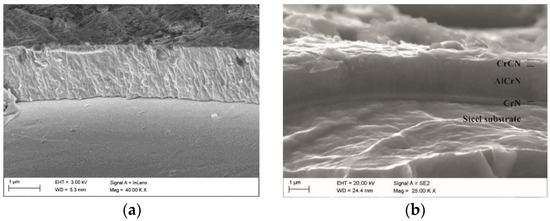
Figure 1.
SEM fracture image of (a) AlCrN, (b) AlCrN + CrCN coating deposited on the steel substrate.
To identify the phase composition of the investigated coating, an X-ray diffraction (XRD) phase analysis was performed. Due to the overlapping of reflections from the substrate and coating material and their intensity, which made the analysis of the obtained results difficult, the grazing incidence geometry (GIXRD) diffraction technique was used (Figure 2). The obtained results were analyzed using the X′Pert Data computer program, and then the phases were identified based on JCPDS cards. In the angular range 2θ from 20° to 100°, the diffraction patterns contain four reflections that can be identified as (111), (200), (220), and (311) for the CrN (fcc) phase. The obtained reflections can be appropriately assigned to the following interplanar spacings: 0.238, 0.206, 0.145, and 0.123 nm for the CrN phase.

Figure 2.
GIXRD spectra of the AlCrN + CrCN coating.
Moreover, some shifts of the reflexes toward higher or lower reflection angles found on the diffraction patterns may indicate the presence of texture or internal stresses.
The observations of the analyzed coatings and substrate surface topography using atomic force microscopy (Figure 3, Figure 4 and Figure 5) revealed a characteristic surface topography with a significant heterogeneity connected with occurrences of the microdroplets of various sizes, which is related with the essence of the employed PVD process for depositing the coatings.
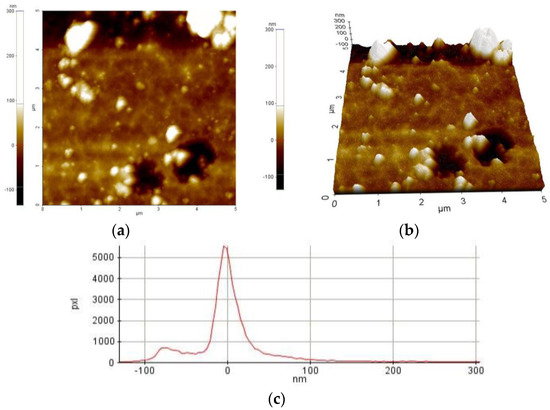
Figure 3.
AFM surface topography of AlCrN coating: (a) 2D image; (b) 3D image; (c) region histogram.

Figure 4.
AFM surface topography of AlCrN + CrCN coating: (a) 2D image; (b) 3D image; (c) region histogram.
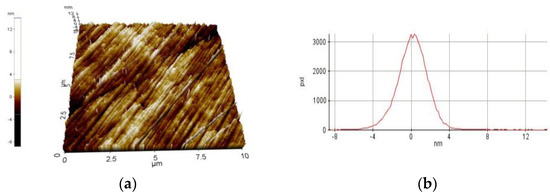
Figure 5.
AFM surface topography of steel substrate: (a) 3D image, (b) region histogram.
The observations of the investigation of the coatings’ surface topography using AFM revealed a varied topography of the coatings. In the case of AlCrN coating, there were large, individual, single, droplet-shaped microparticles. However, in the case of AlCrN + CrCN coating, there were numerous small microparticles with an almost spherical shape. Additionally, an analysis of the surface development was carried out, determining the ratio of the actual area measured for a given sample to its rectangular projection on the XY plane. As a result of the investigations, it was found that the surface of the AlCrN coating showed an increase in surface development by about 8.7%, while in the case of the AlCrN + CrCN coating the surface development was 2.2%. The data mentioned above showed that the CrCN layer reduced the surface inhomogeneity of the AlCrN coating (Table 2). The measurements that were taken also allowed determining the layers’ surface roughness by the root mean square (RMS) and the layers’ surface roughness (Ra). The AlCrN + CrCN coating shows significantly lower roughness.

Table 2.
Characteristics of samples’ topography (AFM).
For analysis of the structure of the AlCrN and AlCrN + CrCN coating produced by arc PVD method on the austenitic steel substrate, STEM and TEM modes were used. Figure 6 shows the STEM-BF image of the AlCrN + CrCN coating on which the substrate (X6CrNiMoTi17-12-2), the AlCrN layer, and the CrCN layer are marked. The individual layers are deposited uniformly and correctly adhere to each other and the substrate material. Profile analysis results (Figure 6b) confirmed the assumed chemical composition and additionally showed the occurrence of three layers in the coating: the interlayer located directly at the substrate, with a thickness of approximately 200 nm, the main AlCrN layer, and an external CrCN layer. The chemical composition of the substrate was confirmed by the analysis of the energy dispersion X-rays spectroscopy (Figure 6c).
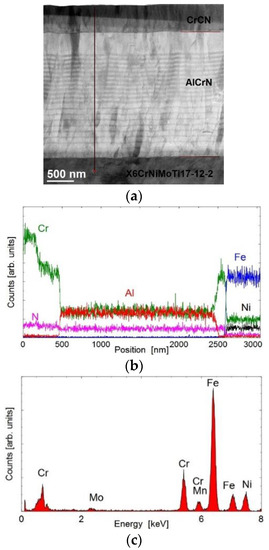
Figure 6.
(a) STEM-BF image of AlCrN + CrCN coating; (b) result of the chemical composition profile analysis; (c) result of the chemical composition analysis of the substrate material.
The interlayer located directly next to the substrate contains Cr and N. It shows a crystalline structure, which was confirmed both by bright field imaging (diffraction contrast) and nanodiffraction pattern identified as CrN in [001] direction (Figure 7). Crystallites have a column structure; their width is about 10–50 nm.
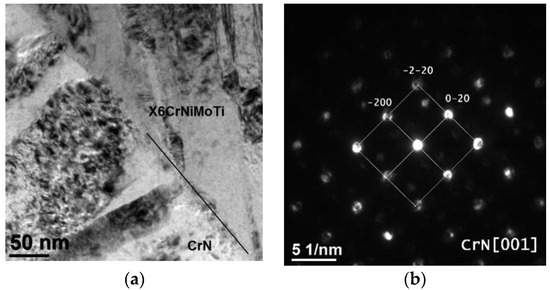
Figure 7.
Structure of the CrN interlayer: (a) TEM-BF, (b) nanodiffraction pattern.
The main layer (Figure 8) with a thickness of approximately 2.3 μm contains Al, Cr, and N. The grains have a column structure with a length comparable to the layer thickness and width from 10 to 200 nm. The clearly visible layered structure of AlCrN film (Figure 8a,b) is the result of the rotational movement of the coated elements in the working chamber of the PVD device and the cyclically variable position of the sample surfaces in relation to the Cr and Al working cathodes. Figure 8c shows the structure of the AlCrN layer using High-resolution transmission electron microscopy (HRTEM) imaging. Based on electron diffraction pattern, the AlCrN phase was identified in the direction [011] (Figure 8d).
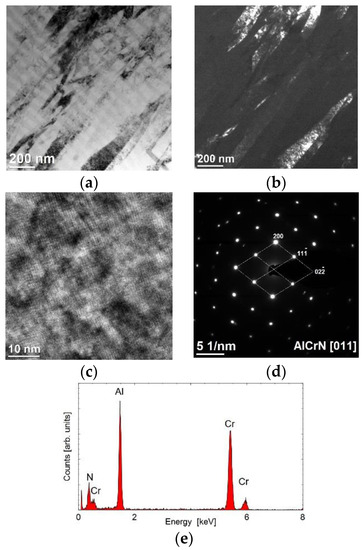
Figure 8.
Structure of the AlCrN layer: (a) TEM-BF image; (b) TEM-DF image based on the reflex (11-1); (c) HRTEM micrograph; (d) electron diffraction pattern; (e) result of the chemical composition analysis.
The external layer (Figure 9) with a thickness of approximately 500 nm does not contain Al. Its chemical composition includes Cr and N (also the chemical composition of Cr, N, and C is possible). The column structure (Figure 9a,b) is similar to that in the main layer. Electron diffraction allows identification of the CrN or CrCN phase in the direction [011] (Figure 9d).
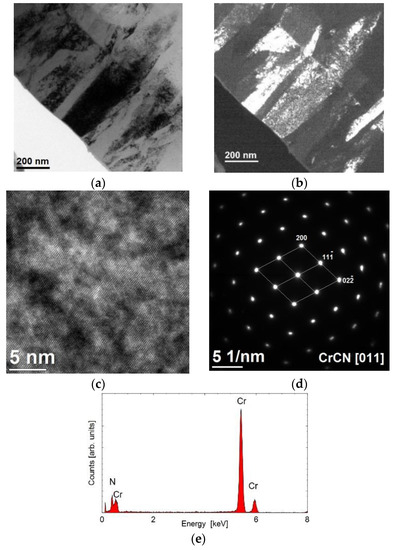
Figure 9.
Structure of the CrCN layer: (a) TEM-BF image; (b) TEM-DF image based on the reflex (11-1); (c) HRTEM micrograph; (d) electron diffraction pattern; (e) result of the chemical composition analysis.
It has been reported earlier that nanocrystalline chromium-based coatings demonstrated good tribological and mechanical properties as well as oxidation resistance and thermal stability compared to coatings used on an industrial scale [27]. The appropriate form of the structure and properties of the coating mentioned above occurred as a result of optimization of deposition conditions and choice of the coating material. HRTEM examination of the AlCrN and CrCN showed that the coatings consisted of fine crystallites (Figure 8c and Figure 9c), which corresponds to the results achieved by earlier investigations [17,28,29].
The scratch-test investigation is the most frequently performed test to examine the characteristics of the cohesive and adhesive strength of coatings. Therefore, the values of the critical load characterizing the adhesion of the coatings to the substrate material were determined with a linearly increasing load by scratch-test method (Figure 10 and Figure 11) and by in situ optical metallographic observation (Figure 12 and Figure 13) [30,31,32,33]. The first critical load LC1 corresponds to the first coating damage, which is usually related to cohesive failures associated with the cracking of material within the coating (Figure 12a and Figure 13a). The second critical load LC2 corresponds to the first adhesion-related failure, which is connected with the start of complete delamination of the coating (Figure 12b and Figure 13b). The examined coatings show high values of critical load. The first critical load LC1 occurred at 19 and 13 N, while the second critical load LC2 occurred at 40 and 46 N for AlCrN and AlCrN + CrCN coating, respectively. In order to determine the nature of the damage formed during the scratch test, optical observations of the scratches were made. Under load below the critical load, the first symptoms of damage of the coatings were small bilateral chipping on the edge of the scratch track. At critical load, chipping occurred, combined with local delamination of the coatings.

Figure 10.
Friction force (Ft) and acoustic emission (AE) as a function of the load (Fn) for AlCrN coating.

Figure 11.
Friction force (Ft) and acoustic emission (AE) as a function of the load (Fn) for AlCrN + CrCN coating.

Figure 12.
Scratch-failure images of the AlCrN coating: (a) LC1, (b) LC2.
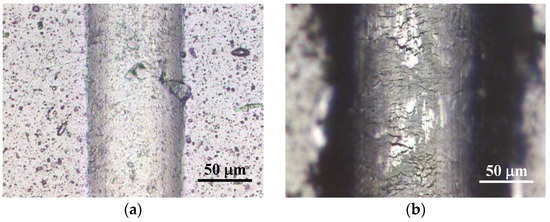
Figure 13.
Scratch-failure images of the AlCrN + CrCN coating: (a) LC1, (b) LC2.
To determine the tribological properties of the investigation coatings, an abrasion test under dry slide friction conditions was carried out by the ball-on-disc method. Three tests were performed for each of the tested coatings. Figure 14 and Figure 15 present the graph of friction coefficient µ changes obtained during wear tests in relation to the sliding distance.
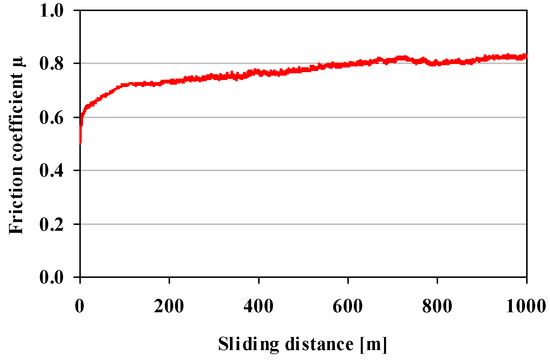
Figure 14.
Dependence of the friction coefficient on the sliding distance during the wear test for the AlCrN coating.
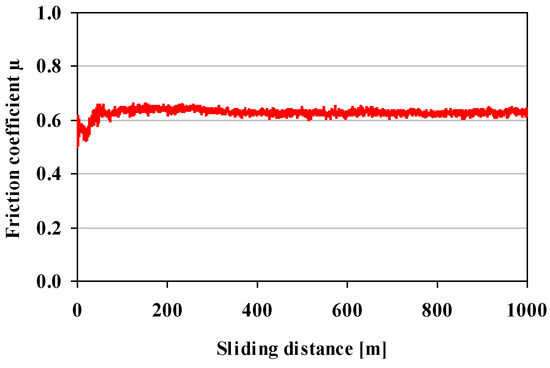
Figure 15.
Dependence of the friction coefficient on the sliding distance during the wear test for the AlCrN + CrCN coating.
The initial transition state was unstable, during which the friction coefficient decreased, then rose with the sliding distance increase, and stabilized, which in the analyzed cases occurred after a distance of about 100 m. In the case of the AlCrN coating, a slight increase of the friction coefficient during the sliding distance was visible. The addition of CrCN as the top layer to AlCrN caused a reduction of the friction coefficient. It was related to the addition of carbon contained in the CrCN layer. It created a transfer layer to facilitate sliding by reducing the contact surface between the coating and the ball [34]. The values of the friction coefficient for AlCrN were consistent with the literature [35,36], similarly as in the case of AlCrN + CrCN, where the results corresponded to the tribological properties of the CrCN layer [2,20,37,38]. However, as shown by studies conducted by Warcholinski and others [15] on CrCN coatings, this coefficient may be reduced by changing the percentage of carbon in the coating. An additional analysis of the weight loss of the tested coatings (Table 3), as well as the measurements of the width of the abrasion trace (Figure 16), showed that the coatings had good wear resistance.

Table 3.
The average value of the friction coefficient and the weight loss of tested coatings.

Figure 16.
The wear surface topography of the (a) AlCrN, (b) AlCrN + CrCN coating.
The weight loss and abrasion trace width measurements of the AlCrN coating made based on the ball-on-disc test were 0.011 g and 711–720 µm, respectively. In the case of the AlCrN + CrCN coating, the weight loss decreased (0.009 g) and the width of the abrasion trace was in the range of 424–428 µm, which proved its better wear resistance. Abrasion trace in the case of AlCrN + CrCN was much narrower than in the AlCrN. In both cases, no matter of complete coatings wear-through occurred because the maximum wear-in depths were below their thicknesses.
The conducted research on the structural, mechanical, and tribological properties of the analyzed coatings produced by PVD process and the obtained investigation results indicate the suitability of the produced AlCrN + CrCN coating for new application possibilities. Thanks to the obtained nanocrystalline structure, good adhesion to the substrate, and good tribological properties, they can provide higher wear resistance compared to the coatings currently used on an industrial scale.
4. Conclusions
The coating system consisting of AlCrN layer and carbon-based CrCN layer was successfully deposited on the X6CrNiMoTi17-12-2 steel substrate.
Adhesion tests showed a good adhesion of the coating to the substrate. The critical load value for the AlCrN + CrCN coating was 46 N. The investigation indicated the occurrence of a transition zone between the substrate and the coating, which affected the improved adhesion.
According to the results of the ball-on-disc test, the investigated coating showed good tribological properties. The friction coefficient of the AlCrN + CrCN coating was examined under the technically dry friction conditions, and its value equaled 0.62. The use of an additional CrCN layer on the surface of the AlCrN coating caused a decrease in the friction coefficient by 19%. The beneficial tribological properties of the friction associations with the participation of the investigated AlCrN + CrCN coating indicated that it may be applied to cover selected elements of abrasive joints of machines and tools and, consequently, to enhance their efficiency and durability.
The chemical composition and structure, to a large extent, determined the suitability of the investigated layers as protective coatings. The tests of steel specimens with AlCrN + CrCN coating deposited onto their surface with TEM indicated a sharp transition zone between the substrate material and the layer. In general, no reasons were implying the epitaxial growth of the examined layers. Although coatings with better tribological properties exist, the potential of the CrCN layer is relatively poorly studied and very promising.
Author Contributions
Conceptualization, K.L. and A.P.; methodology, K.L. and J.S.; validation, K.L., A.P., and M.P. (Mirosława Pawlyta); formal analysis, K.L. and M.P. (Mirosława Pawlyta); investigation, K.L., A.P., M.P. (Mirosława Pawlyta), B.C., J.S., M.P. (Mieczysław Pancielejko), B.S.-L., and T.W.; resources, A.P.; data curation, K.L.; writing—original draft preparation, A.P.; writing—review and editing, K.L. and T.T.; visualization, A.P.; supervision, K.L. All authors have read and agreed to the published version of the manuscript.
Funding
This research received no external funding.
Conflicts of Interest
The authors declare no conflict of interest.
References
- Lecis, N.; La Vecchia, G.M.; Boniardi, M.; D’Errico, F. Fatigue behavior of duplex-treated samples coated with Cr(C,N) film. Surf. Coat. Technol. 2006, 201, 2335–2340. [Google Scholar] [CrossRef]
- Tong, C.-Y.; Lee, J.-W.; Kuo, C.-C.; Chan, Y.-C.; Chen, H.-W.; Duh, J.-G. Effects of carbon content on the microstructure and mechanical property of cathodic arc evaporation deposited CrCN thin films. Surf. Coat. Technol. 2013, 231, 482–486. [Google Scholar] [CrossRef]
- Lukaszkowicz, K.; Dobrzański, L.A.; Zarychta, A. Structure, chemical and phase compositions of coatings deposited by reactive magnetron sputtering onto the brass substrate. J. Mater. Process. Technol. 2004, 157–158, 380–387. [Google Scholar] [CrossRef]
- Ye, Y.; Wang, Y.; Chen, H.; Li, J.; Zhou, S.; Xue, Q. Influences of bias voltage on the microstructures and tribological performances of Cr-C-N coatings in seawater. Surf. Coat. Technol. 2015, 270, 305–313. [Google Scholar] [CrossRef]
- Gilewicz, A.; Warcholinski, B. Tribological properties of CrCN/CrN multilayer coatings. Tribol. Int. 2014, 80, 34–40. [Google Scholar] [CrossRef]
- Zhou, H.; Zheng, J.; Gui, B.; Geng, D.; Wang, Q. AlTiCrN coatings deposited by hybrid HIPIMS/DC magnetron co-sputtering. Vacuum 2017, 136, 129–136. [Google Scholar] [CrossRef]
- Mo, J.L.; Zhu, M.H.; Leyland, A.; Matthews, A. Impact wear and abrasion resistance of CrN, AlCrN and AlTiN PVD coatings. Surf. Coat. Technol. 2013, 215, 170–177. [Google Scholar] [CrossRef]
- Chen, W.; Zheng, J.; Lin, Y.; Kwon, S.; Zhang, S. Comparison of AlCrN and AlCrTiSiN coatings deposited on the surface of plasma nitrocarburized high carbon steels. Appl. Surf. Sci. 2015, 332, 525–532. [Google Scholar] [CrossRef]
- Forsén, R.; Johansson, M.P.; Odén, M.; Ghafoor, N. Effects of Ti alloying of AlCrN coatings on thermal stability and oxidation resistance. Thin Solid Films 2013, 534, 394–402. [Google Scholar] [CrossRef]
- Reiter, A.E.; Derflinger, V.H.; Hanselmann, B.; Bachmann, T.; Sartory, B. Investigation of the properties of Al1−xCrxN coatings prepared by cathodic arc evaporation. Surf. Coat. Technol. 2005, 200, 2114–2122. [Google Scholar] [CrossRef]
- Sabitzer, C.; Paulitsch, J.; Kolozsvári, S.; Rachbauer, R.; Mayrhofer, P.H. Impact of bias potential and layer arrangement on thermal stability of arc evaporated Al-Cr-N coatings. Thin Solid Films 2016, 610, 26–34. [Google Scholar] [CrossRef]
- Lomello, F.; Sanchette, F.; Schuster, F.; Tabarant, M.; Billard, A. Influence of bias voltage on properties of AlCrN coatings prepared by cathodic arc deposition. Surf. Coat. Technol. 2013, 224, 77–81. [Google Scholar] [CrossRef]
- Endrino, J.L.; Fox-Rabinovich, G.; Reiter, A.; Veldhuis, S.V.; Galindo, R.E.; Albella, J.M.; Marco, J.F. Oxidation tuning in AlCrN coatings. Surf. Coat. Technol. 2007, 201, 4505–4511. [Google Scholar] [CrossRef]
- Franz, F.; Neidhardt, J.; Sartory, B.; Kaindl, R.; Tessadri, R.; Polcik, P.; Derflinger, V.H.; Metterer, C. High-temperature low-friction properties of vanadium-alloyed AlCrN coatings. Tribol. Lett. 2006, 23, 101–107. [Google Scholar] [CrossRef]
- Warcholiński, B.; Gilewicz, A.; Kukliński, Z.; Myśliński, P. Arc-evaporated CrN, CrN and CrCN coatings. Vacuum 2008, 83, 715–718. [Google Scholar] [CrossRef]
- Ye, Y.; Wang, Y.; Wang, C.; Li, J.; Yao, Y. An analysis on tribological performance of CrCN coatings with different carbon contents in seawater. Tribol. Int. 2015, 91, 131–139. [Google Scholar] [CrossRef]
- Pengfei, H.; Bailing, J. Study on tribological property of CrCN coating based on magnetron sputtering plating technique. Vacuum 2011, 85, 994–998. [Google Scholar] [CrossRef]
- Kuprin, A.S.; Kolodiy, I.V.; Ovcharenko, V.D.; Tolmachova, G.N.; Gilewicz, A.; Lupicka, O.; Warcholiński, B. Effect of carbon on the properties of CrN coatings formed by cathodic arc evaporation in stationary system. Probl. Atom. Sci. Technol. 2016, 104, 72–75. [Google Scholar]
- Čekada, M.; Maček, M.; Merl, D.K.; Panjan, P. Properties of Cr(C,N) hard coatings deposited in Ar-C2H2-N2 plasma. Thin Solid Films 2003, 433, 174–179. [Google Scholar] [CrossRef]
- Guan, J.J.; Wang, H.Q.; Qin, L.Z.; Liao, B.; Liang, H.; Li, B. Phase transitions of doped carbon in CrCN coatings with modified mechanical and tribological properties via filtered cathodic vacuum arc deposition. Nucl. Instrum. Meth. B 2017, 397, 86–91. [Google Scholar] [CrossRef]
- Ghasemi, R.; Elmquist, L. Cast iron and the self-lubricating behaviour of graphite under abrasive wear conditions. In Proceedings of the 10th International Symposium on the Science and Processing of Cast Iron—SPCI10, Mar del Plata, Argentina, 10–13 November 2014. [Google Scholar]
- Fisher, J.; Hu, X.Q.; Stewart, T.D.; Williams, S.; Tipper, J.L.; Ingham, E.; Stone, M.H.; Davies, C.; Hatto, P.; Bolton, J.; et al. Wear of surface engineered metal-on-metal hip prostheses. J. Mater. Sci. Mater. M 2004, 15, 225–235. [Google Scholar] [CrossRef] [PubMed]
- Willmann, H.; Mayrhofer, P.H.; Persson, P.O.; Reiter, A.E.; Hultman, L.; Mitterer, C. Thermal stability of Al-Cr-N hard coatings. Scr. Mater. 2006, 54, 1847–1851. [Google Scholar] [CrossRef]
- Feng, Y.; Zhang, L.; Ke, R.; Wan, Q.; Wang, Z.; Lu, Z. Thermal stability and oxidation behavior of AlTiN, AlCrN and AlCrSiWN coatings. Int. J. Refract. Met. Hard 2014, 43, 241–249. [Google Scholar] [CrossRef]
- Chen, M.; Wu, D.; Chen, W.; Zhang, S. Structural optimisation and electrochemical behaviour of AlCrN coatings. Thin Solid Films 2016, 612, 400–406. [Google Scholar] [CrossRef]
- Kolaklieva, L.; Kakanakov, R.; Stefanov, P.; Kovacheva, D.; Atanasova, G.; Russev, S.; Chitanov, V.; Cholakova, T.; Bahchedjiev, C. Mechanical and structural properties of nanocomposite CrAlSiN-AlSiN coating with periodically modulated composition. Coatings 2020, 10, 41. [Google Scholar] [CrossRef]
- Veprek, S.; Zhang, R.F.; Veprek-Heijman, M.G.J.; Sheng, S.H.; Argon, A.S. Superhard nanocomposites: Origin of hardness enhancement, properties and applications. Surf. Coat. Technol. 2010, 204, 1898–1906. [Google Scholar] [CrossRef]
- Tillmann, W.; Stangier, D.; Laemmerhirt, I.A.; Biermann, D.; Freiburg, D. Investigation of the tribological properties of high-feed milled structures and Cr-based hard PVD-coatings. Vacuum 2016, 131, 5–13. [Google Scholar] [CrossRef]
- Myśliński, P.; Szparaga, Ł.; Gilewicz, A.; Mydłowska, K.; Piątkowska, A. Investigations of the thermo-mechanical stability of hybrid layers for tribological applications: Nitrided layer/CrCN coating system. Vacuum 2018, 148, 276–285. [Google Scholar] [CrossRef]
- Javed, H.; Merle, B.; Preiß, E.; Hivet, R.; Benedetto, A.; Göken, M. Mechanical characterization of metallic thin films by bulge and scratch testing. Surf. Coat. Technol. 2016, 289, 69–74. [Google Scholar] [CrossRef]
- Pökl, F.; Hardes, C.; Theisen, W. Deformation behavior and dominant abrasion micro mechanism of tempering steel with varying carbon content under controlled scratch testing. Wear 2019, 422–423, 212–222. [Google Scholar]
- Beake, B.D.; Endrino, J.L.; Kimpton, C.; Fox-Rabinovich, G.S.; Veldhuis, S.C. Elevated temperature repetitive micro-scratch testing of AlCrN, TiAlN and AlTiN PVD coatings. Int. J. Refract. Met. Hard 2017, 69, 215–226. [Google Scholar] [CrossRef]
- Vencl, A.; Arostegui, S.; Favaro, G.; Zivic, F.; Mrdak, M.; Mitrović, S.; Popovic, V. Evaluation of adhesion/cohesion bond strength of the thick plasma spray coatings by scratch testing on coatings cross-section. Tribol. Int. 2011, 44, 1281–1288. [Google Scholar] [CrossRef]
- Choi, E.Y.; Kang, M.C.; Kwon, D.H.; Shin, D.W.; Kim, K.H. Comparative studies on microstructure and mechanical properties of CrN, Cr-C-N and Cr-Mo-N coatings. J. Mater. Process. Technol. 2007, 187–188, 566–570. [Google Scholar] [CrossRef]
- Chang, Y.-Y.; Weng, S.-Y.; Chen, C.-H.; Fu, F.-X. High temperature oxidation and cutting performance of AlCrN, TiVN and multilayered AlCrN/TiVN hard coatings. Surf. Coat. Technol. 2017, 332, 494–503. [Google Scholar] [CrossRef]
- Antonov, M.; Afshari, H.; Baronins, J.; Adoberg, E.; Raadik, T.; Hussainova, I. The effect of temperature and sliding speed on friction and wear of Si3N4, Al2O3, and ZrO2 balls tested against AlCrN PVD coating. Tribol. Int. 2018, 118, 500–514. [Google Scholar] [CrossRef]
- Polcar, T.; Cvrček, L.; Široký, P.; Novák, R. Tribological characteristics of CrCN coatings at elevated temperature. Vacuum 2005, 80, 113–116. [Google Scholar] [CrossRef]
- Ye, Y.; Wang, Y.; Chen, H.; Li, J.; Yao, Y.; Wang, C. Doping carbon to improve the tribological performance of CrN coatings in seawater. Tribol. Int. 2015, 90, 362–371. [Google Scholar] [CrossRef]
Publisher’s Note: MDPI stays neutral with regard to jurisdictional claims in published maps and institutional affiliations. |
© 2020 by the authors. Licensee MDPI, Basel, Switzerland. This article is an open access article distributed under the terms and conditions of the Creative Commons Attribution (CC BY) license (http://creativecommons.org/licenses/by/4.0/).